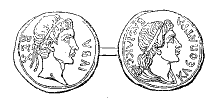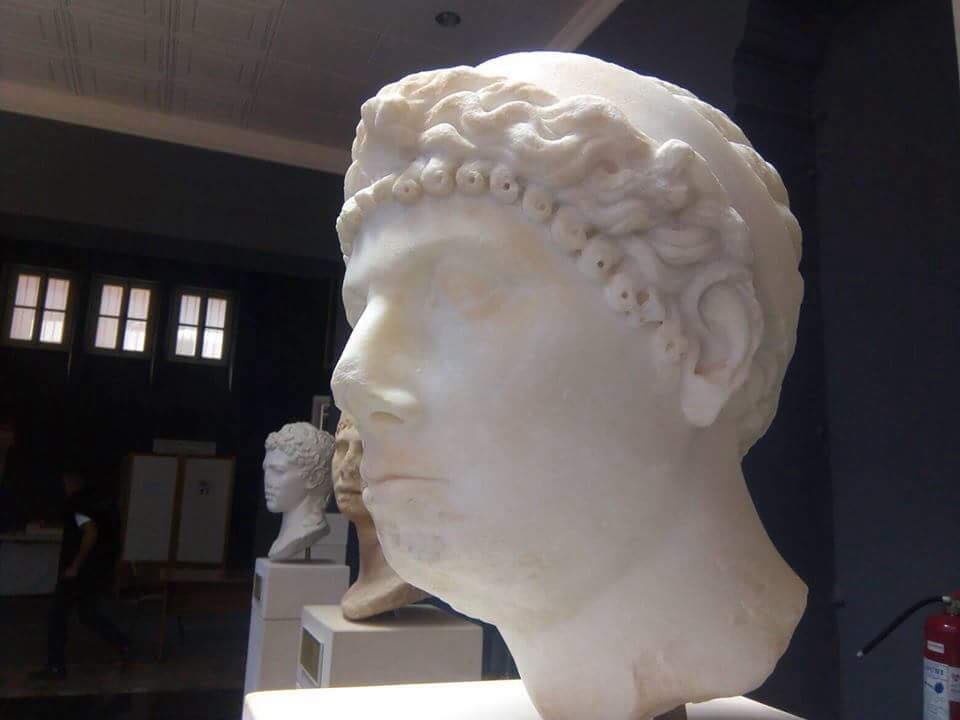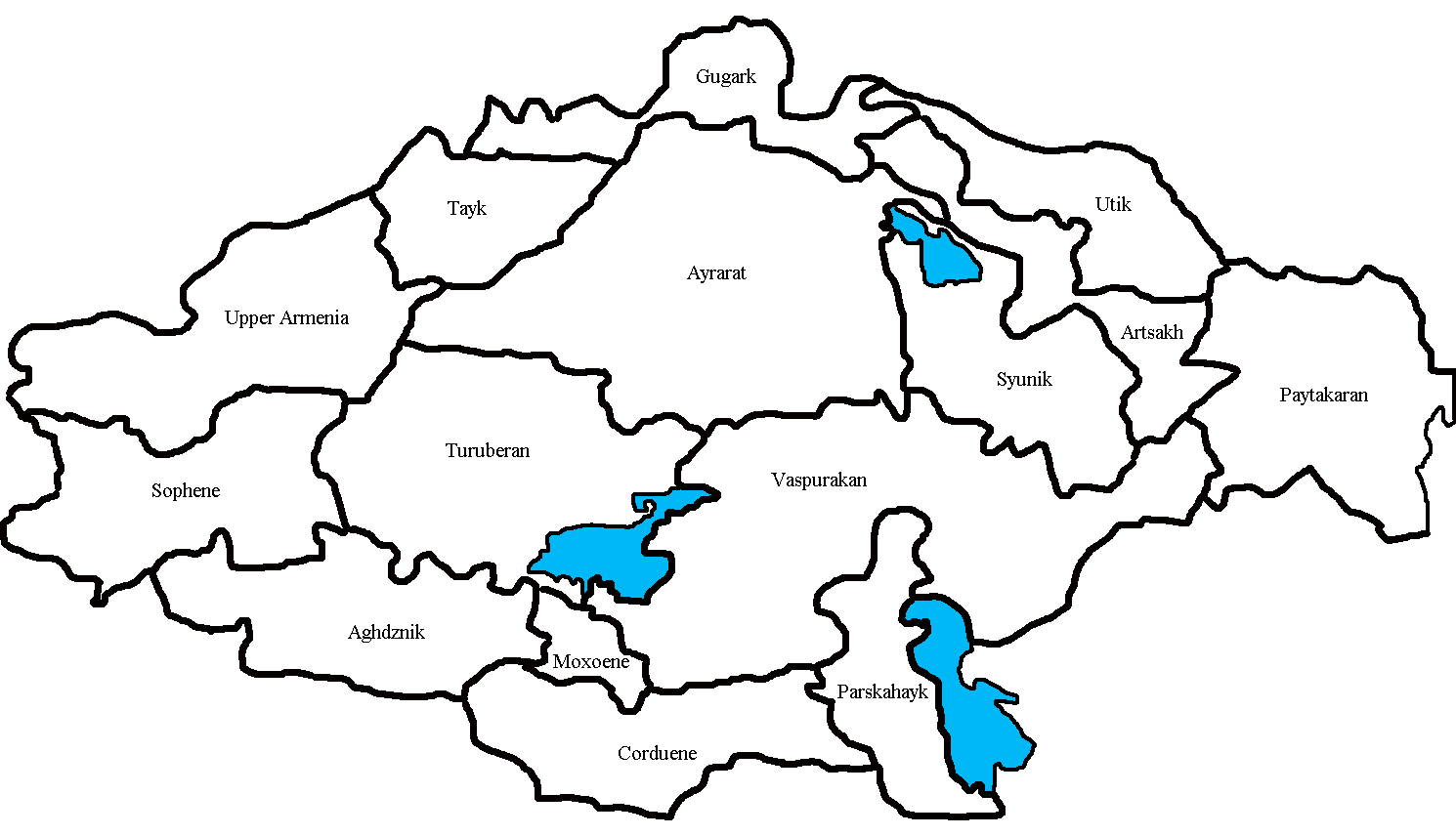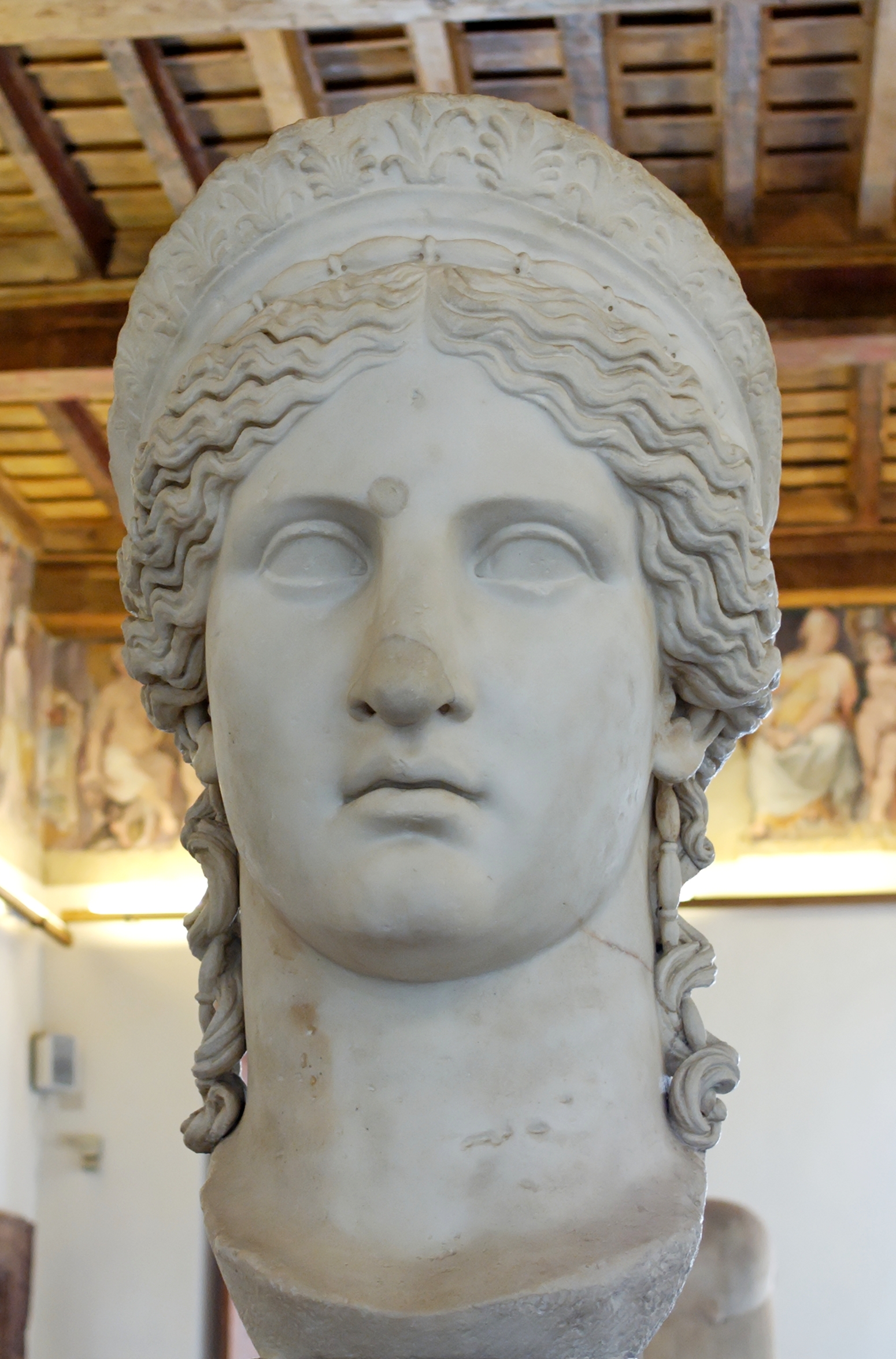|
Sohaemus Of Emesa
Gaius Julius Sohaemus Philocaesar Philorhomaeus ( el, Γάιος Ιούλιος Σόαιμος Φιλοκαίσαρ Φιλορωμαίος, ''Gaius Julius Sohaemus, lover of Caesar, lover of Rome'') also known as Sohaemus of Emesa and Sohaemus of Sophene, was a prince and a Roman Client Priest King from Syria who lived in the 1st century. He ruled the Emesan kingdom from 54 until 73. His name may derive from the Aramaic root ''ŠḤM'', which described the color black. Family and early life Sohaemus was a member of the Royal family of Emesa. He was the second born son and a child to Priest King Sampsiceramus II who ruled the Emesene Kingdom from 14 until 42 and Queen Iotapa. He had an elder brother called Gaius Julius Azizus, who was the first husband of the Herodian Princess Drusilla and had two sisters: Iotapa who married the Herodian Prince Aristobulus Minor and Mamaea. Sohaemus was born and raised in Emesa. His paternal grandfather was the former Emesene Priest Kin ... [...More Info...] [...Related Items...] OR: [Wikipedia] [Google] [Baidu] |
Roman Empire
The Roman Empire ( la, Imperium Romanum ; grc-gre, Βασιλεία τῶν Ῥωμαίων, Basileía tôn Rhōmaíōn) was the post-Republican period of ancient Rome. As a polity, it included large territorial holdings around the Mediterranean Sea in Europe, North Africa, and Western Asia, and was ruled by emperors. From the accession of Caesar Augustus as the first Roman emperor to the military anarchy of the 3rd century, it was a Principate with Italia as the metropole of its provinces and the city of Rome as its sole capital. The Empire was later ruled by multiple emperors who shared control over the Western Roman Empire and the Eastern Roman Empire. The city of Rome remained the nominal capital of both parts until AD 476 when the imperial insignia were sent to Constantinople following the capture of the Western capital of Ravenna by the Germanic barbarians. The adoption of Christianity as the state church of the Roman Empire in AD 380 and the fall of the Western ... [...More Info...] [...Related Items...] OR: [Wikipedia] [Google] [Baidu] |
Iotapa (daughter Of Artavasdes I)
Iotapa was a princess of Media Atropatene, daughter of King Artavasdes I of Media Atropatene. She was Queen consort of King Mithridates III of Commagene. Iotapa was of Median, Armenian and Greek descent. She was the daughter and one of the children born to King Artavasdes I of Media Atropatene. In 33 BC, she was engaged to her distant relative, the Ptolemaic Prince Alexander Helios, son of Greek Ptolemaic Queen Cleopatra VII of Egypt and Roman Triumvir Mark Antony. In 30 BC Iotapa was returned to her father after Octavian (future Roman Emperor Augustus) took Alexandria Alexandria ( or ; ar, ٱلْإِسْكَنْدَرِيَّةُ ; grc-gre, Αλεξάνδρεια, Alexándria) is the second largest city in Egypt, and the largest city on the Mediterranean coast. Founded in by Alexander the Great, Alexandri ....Cassius Dio, ''Roman history'' 51.16.2 References {{authority control Ptolemaic dynasty 43 BC births Year of death missing 1st-century BC women 1st- ... [...More Info...] [...Related Items...] OR: [Wikipedia] [Google] [Baidu] |
Julia Urania
Ptolemy of Mauretania ( grc-gre, Πτολεμαῖος, ''Ptolemaîos''; la, Gaius Iulius Ptolemaeus; 13 9BC–AD40) was the last Roman client king and ruler of Mauretania for Rome. He was the son of Juba II, the king of Numidia and a member of the Berber Massyles tribe, as well as a descendant of the Ptolemaic dynasty via his mother Cleopatra Selene II. Early life Ptolemy was the son of King Juba II and Queen Cleopatra Selene II of Mauretania. His birth date is not certainly known but must have occurred before his mother's death, which has been estimated to have taken place in 5BC. He had a sister (possibly younger) who is evidenced by an Athenian inscription, but her name has not been preserved. She may have been called Drusilla. His father Juba II was the son of King Juba I of Numidia, who was descended from the Berbers of North Africa and was an ally to the Roman Triumvir Pompey. His mother Cleopatra Selene II was the daughter of the Ptolemaic Greek Queen Cl ... [...More Info...] [...Related Items...] OR: [Wikipedia] [Google] [Baidu] |
Ptolemy Of Mauretania
Ptolemy of Mauretania ( grc-gre, Πτολεμαῖος, ''Ptolemaîos''; la, Gaius Iulius Ptolemaeus; 13 9BC–AD40) was the last Roman client king and ruler of Mauretania for Rome. He was the son of Juba II, the king of Numidia and a member of the Berber Massyles tribe, as well as a descendant of the Ptolemaic dynasty via his mother Cleopatra Selene II. Early life Ptolemy was the son of King Juba II and Queen Cleopatra Selene II of Mauretania. His birth date is not certainly known but must have occurred before his mother's death, which has been estimated to have taken place in 5BC. He had a sister (possibly younger) who is evidenced by an Athenian inscription, but her name has not been preserved. She may have been called Drusilla. His father Juba II was the son of King Juba I of Numidia, who was descended from the Berbers of North Africa and was an ally to the Roman Triumvir Pompey. His mother Cleopatra Selene II was the daughter of the Ptolemaic Greek Queen Cleopat ... [...More Info...] [...Related Items...] OR: [Wikipedia] [Google] [Baidu] |
Drusilla (daughter Of Ptolemy Of Mauretania)
Julia Drusilla ( el, Δρουσίλλη; AD 38–79) was a princess of the Roman client kingdom of Mauretania in North Africa. She was the daughter of Ptolemy of Mauretania and thus a great-granddaughter of Cleopatra VII and Mark Antony. She was married to the procurator Marcus Antonius Felix in the reign of Roman emperor Claudius and later the Emesene priest-king Sohaemus. Family Drusilla's lineage is not entirely clear; Tacitus calls her a granddaughter of Cleopatra VII and Mark Antony, which would maker her a daughter of King Juba II and Queen Cleopatra Selene II of Mauretania, but the chronology of her lifespan makes it more likely that she was their great-granddaughter. Drusilla was probably the daughter and only child born of Ptolemy and his wife, Julia Urania. Her mother may have been a member of the Royal family of Emesa. She is mentioned in the funeral inscription of her freedwoman Julia Bodina at Caesaria as ''Queen Julia Urania''. [...More Info...] [...Related Items...] OR: [Wikipedia] [Google] [Baidu] |
Parthia
Parthia ( peo, 𐎱𐎼𐎰𐎺 ''Parθava''; xpr, 𐭐𐭓𐭕𐭅 ''Parθaw''; pal, 𐭯𐭫𐭮𐭥𐭡𐭥 ''Pahlaw'') is a historical region located in northeastern Greater Iran. It was conquered and subjugated by the empire of the Medes during the 7th century BC, was incorporated into the subsequent Achaemenid Empire under Cyrus the Great in the 6th century BC, and formed part of the Hellenistic Seleucid Empire following the 4th-century-BC conquests of Alexander the Great. The region later served as the political and cultural base of the Eastern Iranian Parni people and Arsacid dynasty, rulers of the Parthian Empire (247 BC – 224 AD). The Sasanian Empire, the last state of pre-Islamic Iran, also held the region and maintained the seven Parthian clans as part of their feudal aristocracy. Name The name "Parthia" is a continuation from Latin ', from Old Persian ', which was the Parthian language self-designator signifying "of the Parthians" who were an Iranian ... [...More Info...] [...Related Items...] OR: [Wikipedia] [Google] [Baidu] |
Tigris
The Tigris () is the easternmost of the two great rivers that define Mesopotamia, the other being the Euphrates. The river flows south from the mountains of the Armenian Highlands through the Syrian and Arabian Deserts, and empties into the Persian Gulf. Geography The Tigris is 1,750 km (1,090 mi) long, rising in the Taurus Mountains of eastern Turkey about 25 km (16 mi) southeast of the city of Elazığ and about 30 km (20 mi) from the headwaters of the Euphrates. The river then flows for 400 km (250 mi) through Southeastern Turkey before becoming part of the Syria-Turkey border. This stretch of 44 km (27 mi) is the only part of the river that is located in Syria. Some of its affluences are Garzan, Anbarçayi, Batman, and the Great and the Little Zab. Close to its confluence with the Euphrates, the Tigris splits into several channels. First, the artificial Shatt al-Hayy branches off, to join the Euphrates near Nasiriyah. ... [...More Info...] [...Related Items...] OR: [Wikipedia] [Google] [Baidu] |
Sophene
Sophene ( hy, Ծոփք, translit=Tsopkʻ, grc, Σωφηνή, translit=Sōphēnē or hy, Չորրորդ Հայք, lit=Fourth Armenia) was a province of the ancient kingdom of Armenia, located in the south-west of the kingdom, and of the Roman Empire. The region lies in what is now southeastern Turkey. The region that was to become Sophene was part of the kingdom of Ararat (Urartu) in the 8th-7th centuries BC. After unifying the region with his kingdom in the early 8th century BC, king Argishtis I of Urartu resettled many of its inhabitants in his newly built city of Erebuni (modern day Armenian capital Yerevan). Around 600 BC, Sophene became part of the newly emerged ancient Armenian Kingdom of the Orontids. This dynasty acted as satraps of Armenia first under the Median Empire, later under the Achaemenid Empire. After Alexander the Great's campaigns in 330s BC and the subsequent collapse of the Achaemenid Empire, Sophene remained part of the newly independent kingdom ... [...More Info...] [...Related Items...] OR: [Wikipedia] [Google] [Baidu] |
Roman Province
The Roman provinces (Latin: ''provincia'', pl. ''provinciae'') were the administrative regions of Ancient Rome outside Roman Italy that were controlled by the Romans under the Roman Republic and later the Roman Empire. Each province was ruled by a Roman appointed as governor. For centuries it was the largest administrative unit of the foreign possessions of ancient Rome. With the administrative reform initiated by Diocletian, it became a third level administrative subdivision of the Roman Empire, or rather a subdivision of the imperial dioceses (in turn subdivisions of the imperial prefectures). Terminology The English word ''province'' comes from the Latin word ''provincia''. In early Republican times, the term was used as a common designation for any task or set of responsibilities assigned by the Roman Senate to an individual who held ''imperium'' (right of command), which was often a military command within a specified theatre of operations. In time, the term became t ... [...More Info...] [...Related Items...] OR: [Wikipedia] [Google] [Baidu] |
Nero
Nero Claudius Caesar Augustus Germanicus ( ; born Lucius Domitius Ahenobarbus; 15 December AD 37 – 9 June AD 68), was the fifth Roman emperor and final emperor of the Julio-Claudian dynasty, reigning from AD 54 until his death in AD 68. He was adopted by the Roman emperor Claudius at the age of 13 and succeeded him on the throne. Nero was popular with the members of his Praetorian Guard and lower-class commoners in Rome and its provinces, but he was deeply resented by the Roman aristocracy. Most contemporary sources describe him as tyrannical, self-indulgent, and debauched. After being declared a public enemy by the Roman Senate, he committed suicide at age 30. Nero was born at Antium in AD 37, the son of Gnaeus Domitius Ahenobarbus and Agrippina the Younger, a great-granddaughter of the emperor Augustus. When Nero was two years old, his father died. His mother married the emperor Claudius, who eventually adopted Nero as his heir; when Cla ... [...More Info...] [...Related Items...] OR: [Wikipedia] [Google] [Baidu] |
Claudius
Tiberius Claudius Caesar Augustus Germanicus (; 1 August 10 BC – 13 October AD 54) was the fourth Roman emperor, ruling from AD 41 to 54. A member of the Julio-Claudian dynasty, Claudius was born to Nero Claudius Drusus, Drusus and Antonia Minor at Lugdunum in Roman Gaul, where his father was stationed as a military legate. He was the first Roman emperor to be born outside Italia (Roman Empire), Italy. Nonetheless, Claudius was an Italian of Sabine origins. As he had a limp and slight deafness due to sickness at a young age, he was ostracized by his family and was excluded from public office until his Roman consul, consulship (which was shared with his nephew, Caligula, in 37). Claudius's infirmity probably saved him from the fate of many other nobles during the purges throughout the reigns of Tiberius and Caligula, as potential enemies did not see him as a serious threat. His survival led to him being declared emperor by the Praetorian Guard after Caligula's a ... [...More Info...] [...Related Items...] OR: [Wikipedia] [Google] [Baidu] |









